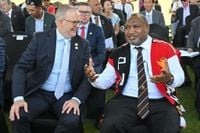In a move that could reshape the security landscape of the South Pacific, Papua New Guinea’s Cabinet has formally approved a landmark defense treaty with Australia, a step widely viewed as a strategic counter to China’s expanding influence in the region. The approval, announced on October 2, 2025, by Papua New Guinea Prime Minister James Marape, marks a significant deepening of military ties between the two largest nations in the South Pacific and signals a new era of alliance-building among U.S. partners.
"Australia has only one other mutual defense treaty of this type and at our request Papua New Guinea will now sign this treaty," Marape stated, underscoring the gravity of the agreement. Australia’s only other such pact is the ANZUS Treaty, inked in 1951 with the United States and New Zealand. This new agreement, often referred to as the Pukpuk Treaty, is set to elevate the relationship between Australia and Papua New Guinea from close neighbors to formal allies—an upgrade both symbolic and practical in a region where great power competition is heating up.
Australian Prime Minister Anthony Albanese echoed the sentiment, saying, "Our two nations are the closest of neighbors and the closest of friends, and this treaty will elevate our relationship to a formal alliance." According to Reuters, Albanese added that he looked forward to signing the treaty with Marape soon, a ceremony that both leaders hope will take place in the coming weeks.
The treaty’s approval did not come without delay. Originally, Marape and Albanese had hoped to sign the agreement during Papua New Guinea’s 50th independence anniversary celebrations in mid-September 2025. However, a crucial Cabinet meeting lacked the required quorum, forcing the leaders to settle for a joint statement reaffirming the pact’s core principles. Now, with Cabinet approval secured, the next steps involve ratification by both countries’ parliaments before the treaty can take full effect.
The substance of the treaty is far more than ceremonial. At its heart, it stipulates that an armed attack on either Australia or Papua New Guinea would be considered a threat to the peace and security of both countries. This mutual defense clause binds the two nations in a manner reminiscent of NATO’s Article 5, raising the stakes for any potential aggressor contemplating hostile actions in the region.
But the agreement goes further. For the first time, Papua New Guineans will be eligible to serve in the Australian Defense Force (ADF), a provision that could see as many as 10,000 Papua New Guineans donning Australian uniforms under dual arrangements. This move is not just about symbolism; it addresses Australia’s longstanding recruitment shortfall and offers Papua New Guineans a unique pathway to Australian citizenship. As noted in the Associated Press, this could prove a game-changer for both countries’ defense establishments, fostering deeper integration of military personnel and equipment.
“This reflects the depth of trust, history, and shared future between our two nations,” Marape said, highlighting the longstanding ties that date back to Australia’s role as Papua New Guinea’s colonial master until the latter’s independence in 1975. Today, Australia’s population stands at about 28 million, while Papua New Guinea is home to roughly 10 million—making them the region’s demographic heavyweights.
The treaty’s timing is no accident. Since 2022, Australia has ramped up efforts to strengthen ties with Pacific island nations, a response to Beijing’s security pact with the Solomon Islands that raised the specter of a Chinese naval base in the South Pacific. The United States has also been active, signing its own defense agreement with Papua New Guinea in 2023 to counter China’s regional ambitions. According to Reuters, Australia’s recent attempts to secure a major security partnership with Vanuatu fell short due to political complications, underscoring the complexity of alliance-building in the Pacific.
China’s growing presence has not gone unnoticed. Since 2019, three Pacific island nations have switched diplomatic recognition from Taiwan to Beijing, and Chinese security cooperation now extends to police training in Fiji, Kiribati, Samoa, Solomon Islands, and Vanuatu. The U.S. and its allies have grown increasingly wary of these developments, viewing them as part of a broader strategy by Beijing to establish a foothold in a region once considered firmly within the Western sphere of influence.
Not surprisingly, China’s embassy in Port Moresby criticized the new Australia-Papua New Guinea treaty, cautioning that such agreements “should not be exclusive in nature, nor should they restrict or prevent a sovereign country from cooperating with a third party for any reason.” The embassy further urged that the treaty "should also refrain from targeting any third party or undermining its legitimate rights and interests," as reported by the Associated Press. While the treaty’s text includes provisions to respect third-party relationships, the diplomatic message from Beijing was clear: China will push back against moves it perceives as attempts to contain its influence.
Papua New Guinea, for its part, finds itself walking a tightrope. While the security pact with Australia aligns it more closely with traditional Western allies, the country also seeks to deepen economic ties with China. As Oliver Nobetau, project director at the Sydney-based Lowy Institute, explained to the Australian Broadcasting Corporation, "The Papua New Guinea government, especially James Marape, has come out and demarcated how they see the bilateral relationships moving forward: now with the security space, siding with Australia’s traditional Western allies. And definitely in the economic and trade space, building up that relationship with China." This balancing act is fraught with risk, as Papua New Guinea tries to maximize the benefits of engagement with both superpowers without alienating either.
Beyond the geopolitical chessboard, the treaty carries real-world implications for the people of both nations. For Papua New Guineans, the prospect of serving in the ADF and potentially gaining Australian citizenship could be life-changing, opening doors to new careers and opportunities. For Australia, the treaty promises to bolster its defense capabilities and reinforce its status as a regional leader at a time when the Pacific is becoming an arena for global competition.
Yet, challenges remain. The treaty must still be ratified by both parliaments, and its success will depend on the willingness of both governments to navigate domestic politics and external pressures. As recent events in Vanuatu have shown, even well-intentioned security agreements can stumble on the rocks of local opposition or shifting alliances.
Still, the approval of the Pukpuk Treaty stands as a milestone in Pacific diplomacy, one that reflects the shifting tides of power and partnership in a region that has become a focal point for global attention. With the ink barely dry on the Cabinet’s decision, all eyes now turn to Port Moresby and Canberra, where the next chapter in this evolving alliance will soon be written.


